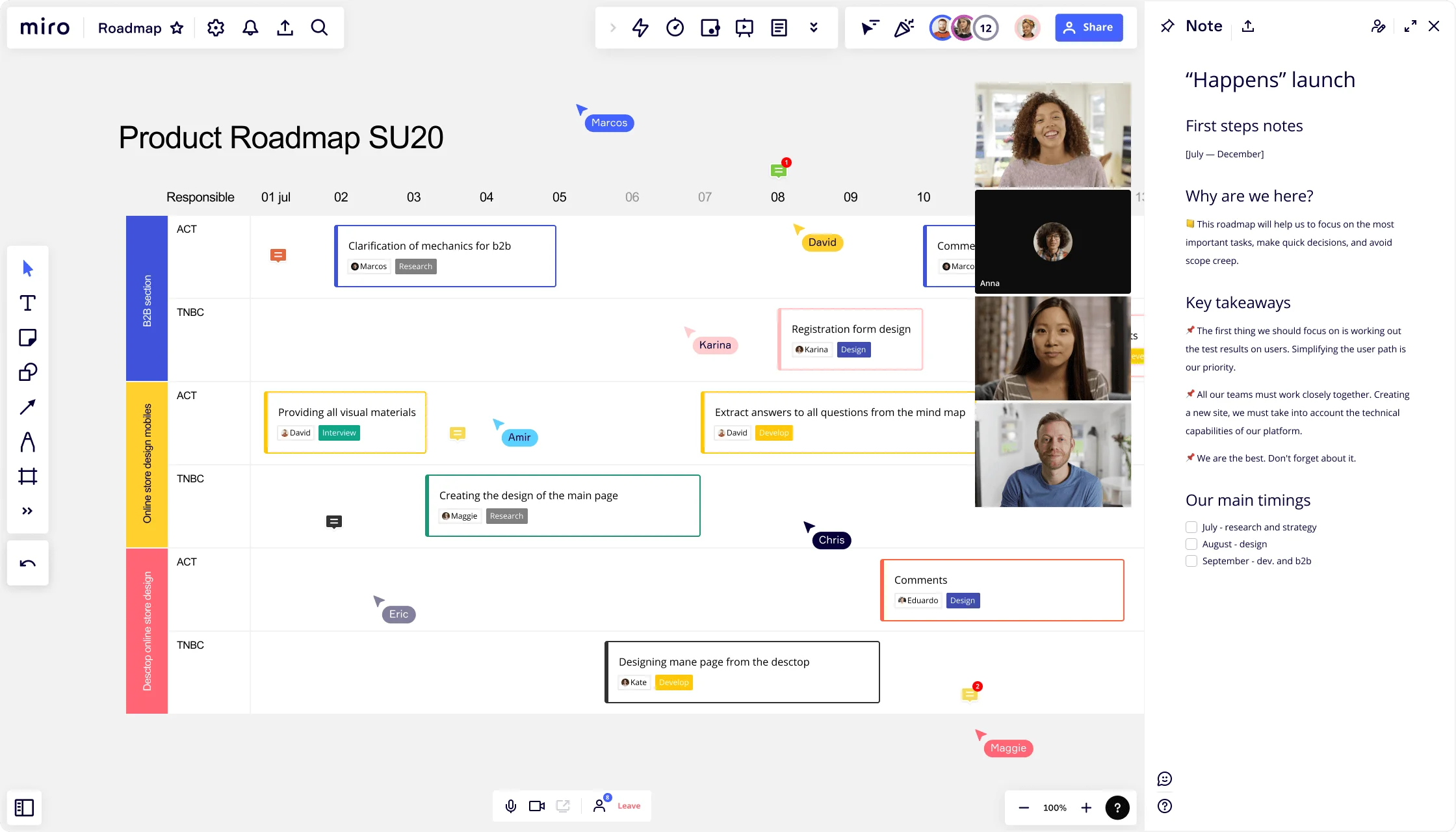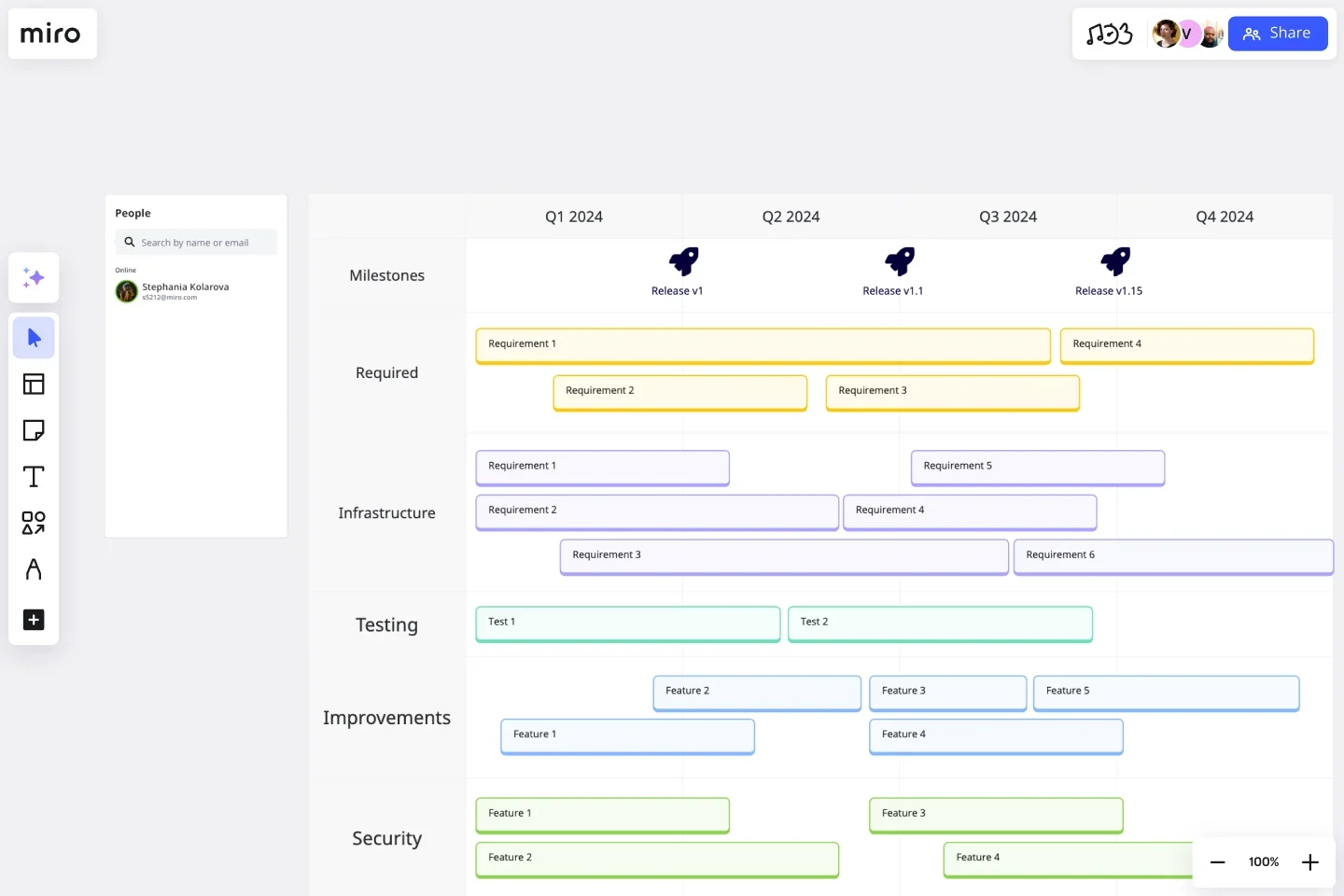
Table of contents
Table of contents
What is a technology roadmap?

What is a technology roadmap, and do you need one?
Technology moves fast. Without a clear plan, teams risk losing focus, misallocating resources, or struggling to align stakeholders. That’s where a technology roadmap comes in. It’s a strategic blueprint that helps teams plan, prioritize, and execute technology initiatives that support business goals.
In this guide, we’ll break down what a technology roadmap is, the different types, how teams use them, and whether you need one for your organization. By the end, you’ll have a clear understanding of how to use a technology roadmap to drive innovation and execution.
Technology roadmap definition
A technology roadmap is a powerful strategic planning tool to communicate the organization's technology strategy. In simple terms, it's a visualization that aligns a company's tech resources with its short and long-term business objectives. This shared vision can provide the following:
A clear path for your company.
Fostering alignment among diverse teams.
Helping manage uncertainties.
Driving innovation forward.
Understanding how a technology roadmap works
The essence of a technology roadmap is its unique focus on aligning tech resources with business goals and strategy. Imagine hiking up a mountain; your roadmap is the trail map that gives you the various routes, the time it would take, the resources you'd need, and the potential challenges you may face. Similarly, technology roadmap templates outline the technologies required, the timeline for development and deployment, the resources necessary, and possible challenges.
Technology roadmaps operate on three levels: strategic, tactical, and operational.
Strategic: At the strategic level, the technology roadmap sets the direction for the company's technology initiatives in alignment with the business goals.
Tactical: At the tactical level, the roadmap guides the selection, development, and deployment of specific technologies.
Operational: At the operational level, the technology roadmap focuses on managing and monitoring the implementation of technologies.
Key components of a technology roadmap
A strong technology roadmap includes several essential elements:
Strategic goals – The high-level business objectives that technology initiatives should support.
Initiatives and projects – The major efforts required to achieve those goals, such as adopting new infrastructure, improving security, or launching AI-driven features.
Timelines – A rough time horizon for each initiative (e.g., short-term, mid-term, long-term) without rigid deadlines.
Dependencies – Key relationships between initiatives, teams, or systems that affect implementation.
Milestones – Significant achievements that indicate progress, like launching a beta version or completing a system migration.
For Agile teams, a technology roadmap is a living document—it evolves as priorities shift, ensuring flexibility while keeping stakeholders aligned.
What are the types of technology roadmaps?
Technology roadmaps aren’t one-size-fits-all. Depending on your organization’s goals, you might need a specific type of roadmap. Here are the most common ones:
Product Technology Roadmap: Helps product managers and engineering teams align technical improvements with product development. It focuses on backend updates, APIs, and technical enablers that support new product features. Check out our roadmap template if you need to focus on the technologies needed to develop and improve specific products or product lines.
IT Roadmap: Used by IT teams to plan infrastructure upgrades, system migrations, security enhancements, and overall tech stack improvements. It highlights the technology needed to support an organization's IT infrastructure, such as hardware, software, networks, etc.
Research and Development (R&D) Roadmap: Organizations that focus on creating new and innovative technology use this roadmap, which details the path from research and development to the final product.
Industry Technology Roadmap: These are commonly used in industries undergoing rapid technological changes, like AI or biotechnology. This type of roadmap helps businesses stay ahead of technology trends. As AI adoption grows, many teams create dedicated roadmaps to integrate automation and machine learning capabilities into their products and operations.
Choosing the right roadmap depends on your organization’s needs, but most companies benefit from a mix of these approaches.
How teams use technology roadmaps
A well-structured technology roadmap acts as a north star for product and engineering teams, helping them prioritize and execute efficiently. Here’s how different teams benefit from it:
For product managers
Align technical development with product strategy.
Prioritize features based on business impact.
Keep stakeholders informed on upcoming changes.
For CTOs & tech leaders
Plan long-term technology investments.
Ensure the tech stack remains scalable and secure.
Align engineering teams with business priorities.
For startup founders
Make informed decisions about technology adoption.
Align investor expectations with realistic development timelines.
Ensure early-stage product development supports future scaling needs.
Do you need a technology roadmap? Things to consider
Not every team needs a formal roadmap, but if you’re facing any of these challenges, it might be time to create one:
Lack of alignment – Teams and stakeholders aren’t on the same page about technology priorities.
Frequent changes in direction – Shifting priorities cause confusion and inefficiencies.
Resource misallocation – Teams invest in the wrong tools or projects due to a lack of long-term planning.
Technical debt buildup – Without a clear roadmap, teams may accumulate technical debt that slows down future development.
A technology roadmap isn’t just for large enterprises—it’s a valuable tool for startups and mid-sized companies looking to scale efficiently.
Discover our technology roadmap template
Creating a technology roadmap from scratch can feel overwhelming. That’s why we’ve designed our technology roadmap template to help teams build clear, actionable roadmaps that support their business strategy.

Our technology roadmap template helps you:
Define and visualize technology initiatives.
Map out dependencies and priorities.
Collaborate in real-time or asynchronously with your team.
How to use our technology roadmap template
Miro’s technology roadmap template is designed to help teams create a clear, strategic plan for their technology initiatives. Here’s how to get the most out of it:
Define your strategic goals – Start by outlining your company’s high-level objectives. These could be anything from modernizing infrastructure to enhancing AI capabilities. Adding these at the top of your roadmap ensures that every initiative stays aligned with your business vision.
Break initiatives into time horizons – Instead of setting rigid deadlines, use flexible time horizons like short-term (next 3–6 months), mid-term (6–12 months), and long-term (12+ months). This approach keeps your team agile while providing a clear progression of priorities.
Map dependencies – Many technology initiatives rely on each other. Identify key dependencies between projects, teams, or systems to avoid bottlenecks and ensure smooth execution.
Add key milestones – Highlight significant achievements, such as launching a beta version, completing an infrastructure migration, or rolling out a security upgrade. Milestones provide a sense of progress and keep stakeholders engaged.
Leverage Miro’s collaboration features—With Miro’s innovation workspace, teams can collaborate in real time or asynchronously. Use sticky notes to gather feedback, add comments to clarify tasks, and update the roadmap dynamically as priorities shift.
Here are some tips to keep in mind:
Stay flexible: A technology roadmap is a guide, not a strict plan. Stay flexible and be prepared to pivot when necessary.
Keep it simple: Don’t overcomplicate your roadmap. It should be easy to understand and follow.
Use a tool that helps you visualize processes: A collaborative workspace like Miro, which has an intuitive interface and an extensive range of templates, can make creating a technology roadmap a breeze.
By following these steps, your team can transform this template into a living document that evolves with your business and technology needs. Remember, the key to creating a successful technology roadmap is alignment with your business goals, flexibility to adapt to changes, and regular reviews and refinement.
Create your product strategy with confidence using Miro
Building a technology roadmap shouldn’t be a complicated process. With Miro’s innovation workspace, you can create, refine, and collaborate on your roadmap visually—ensuring that every stakeholder stays aligned.
Whether you’re leading a startup, managing enterprise technology, or developing a groundbreaking product, Miro’s technology roadmap templates give you the clarity and flexibility to execute with confidence.
Ready to bring your technology roadmap to life? Try Miro today and start planning your next big innovation.